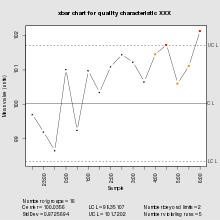Control charts
| Control chart | |
|---|---|
 |
|
| One of the Seven Basic Tools of Quality | |
| First described by | Walter A. Shewhart |
| Purpose | To determine whether a process should undergo a formal examination for quality-related problems |
Control charts, also known as Shewhart charts (after Walter A. Shewhart) or process-behavior charts, are a statistical process control tool used to determine if a manufacturing or business process is in a state of control.
If analysis of the control chart indicates that the process is currently under control (i.e., is stable, with variation only coming from sources common to the process), then no corrections or changes to process control parameters are needed or desired. In addition, data from the process can be used to predict the future performance of the process. If the chart indicates that the monitored process is not in control, analysis of the chart can help determine the sources of variation, as this will result in degraded process performance. A process that is stable but operating outside of desired (specification) limits (e.g., scrap rates may be in statistical control but above desired limits) needs to be improved through a deliberate effort to understand the causes of current performance and fundamentally improve the process.
The control chart is one of the seven basic tools of quality control. Typically control charts are used for time-series data, though they can be used for data that have logical comparability (i.e. you want to compare samples that were taken all at the same time, or the performance of different individuals), however the type of chart used to do this requires consideration.
The control chart was invented by Walter A. Shewhart while working for Bell Labs in the 1920s. The company's engineers had been seeking to improve the reliability of their telephony transmission systems. Because amplifiers and other equipment had to be buried underground, there was a stronger business need to reduce the frequency of failures and repairs. By 1920, the engineers had already realized the importance of reducing variation in a manufacturing process. Moreover, they had realized that continual process-adjustment in reaction to non-conformance actually increased variation and degraded quality. Shewhart framed the problem in terms of Common- and special-causes of variation and, on May 16, 1924, wrote an internal memo introducing the control chart as a tool for distinguishing between the two. Shewhart's boss, George Edwards, recalled: "Dr. Shewhart prepared a little memorandum only about a page in length. About a third of that page was given over to a simple diagram which we would all recognize today as a schematic control chart. That diagram, and the short text which preceded and followed it set forth all of the essential principles and considerations which are involved in what we know today as process quality control." Shewhart stressed that bringing a production process into a state of statistical control, where there is only common-cause variation, and keeping it in control, is necessary to predict future output and to manage a process economically.
...
Wikipedia
